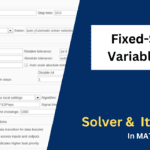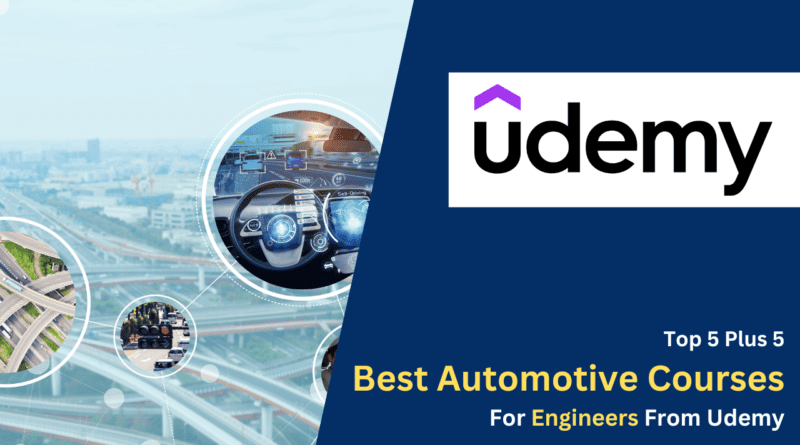Top 5 Plus 5 Best Automotive Courses For Engineers From Udemy
Hello guys, welcome back to our blog. Here in this article, we will discuss the top 10 best automotive courses for engineers, and you guys can purchase these courses from Udemy at affordable prices.
Ask questions if you have any electrical, electronics, or computer science doubts. You can also catch me on Instagram – CS Electrical & Electronics.
Also, read:
- Top 11 Free Courses On Battery For Engineers With Documents
- What Is Vector CANoe Tool, Why It Is Used In The Automotive Industry
- What Is TCM, Transmission Control Module, Working, Purpose
Best Automotive Courses For Engineers
10. CAPL Programming from Scratch
This course seems comprehensive, covering a wide range of topics related to CAPL programming. Here’s a breakdown of what you’ll likely learn:
- Introduction to CAPL: Understand what CAPL is, its features, benefits, and applications.
- CAPL Basics: Learn about setting up the CAPL environment, data types, variables, constants, operators, control structures, functions, procedures, and event, and timer handling.
- CAPL Messages: Explore communication protocols like CAN and LIN, message structure, sending and receiving messages, message manipulation, signal access, and error handling.
- CAPL Functions: Dive into built-in functions, string manipulation, mathematical operations, time and date handling, conversions, file handling, and creating user-defined functions.
- CAPL Advanced Topics: Explore diagnostics, simulation, integration with other languages, performance optimization, and debugging techniques.
- CAPL Best Practices: Understand writing clean and maintainable code, error, and exception handling, documentation, code organization, and coding standards.
- CAPL Case Studies and Examples: Apply CAPL in real-world scenarios through case studies and examples.
Additionally, the course promises to cover CAPL for various protocols like UDS, CAN, LIN, and Ethernet, making it suitable for testers and developers working in automotive software engineering. It’s designed for beginners to moderate-level techies or students without any prerequisites, starting from scratch and providing detailed explanations and exercises for scripting.
By the end of the course, you should have a solid understanding of CAPL programming and its applications in automotive software development and testing.
Click here: CAPL Programming from Scratch
09. AUTOSAR DIAGNOSTICS (DEM, DCM, OBD, UDS)
This course on Autosar Diagnostics seems well-structured and comprehensive, catering to both experienced professionals and freshers in the automotive industry. Here’s what learners can expect to gain:
- Complete Understanding of Diagnostic Stack in AUTOSAR: Gain insight into the architecture and components of the diagnostic stack within the AUTOSAR framework.
- Understanding of Main Diagnostic Modules: Dive into the specifics of the Diagnostic Event Manager (DEM) and Diagnostic Communication Manager (DCM), learning about their functionalities, configurations, and interactions with other modules.
- Understanding of UDS and OBD Protocols: Explore the Unified Diagnostic Services (UDS) and On-Board Diagnostics (OBD) protocols, their roles in vehicle diagnostics, and how they are implemented within the AUTOSAR environment.
- Thorough Knowledge about Practical Use Cases: Learn through practical examples and use cases, gaining hands-on experience in applying diagnostic concepts to real-world AUTOSAR projects.
The course emphasizes practical application and aims to equip learners with the skills and knowledge needed to work effectively with diagnostic functionalities in AUTOSAR-related projects. It also highlights the importance of feedback from the audience, indicating a commitment to ongoing improvement and updates to the course content.
While the course assumes a basic knowledge of AUTOSAR as a prerequisite, it seems suitable for anyone looking to learn about Autosar Diagnostics from scratch, whether they are experienced professionals seeking to deepen their understanding or newcomers to the field.
Click here: AUTOSAR DIAGNOSTICS (DEM, DCM, OBD, UDS)
08. Advanced Driver Assistance Systems (ADAS)
This course on Advanced Driver Assistance Systems (ADAS) appears to be a comprehensive resource for individuals working or aspiring to work in the automotive industry. Here’s what learners can expect to gain:
- Understanding of ADAS in General: Learn about the fundamentals of Advanced Driver Assistance Systems, their importance in modern vehicles, and their role in enhancing road safety.
- Role of ADAS towards Autonomous Driving: Explore how ADAS technologies contribute to the development of autonomous driving systems, aligning with the SAE levels of autonomy.
- Sensors Used in ADAS: Gain insight into the various sensors utilized in ADAS systems, such as radar, lidar, cameras, and ultrasonic sensors, and understand their functions and applications.
- Testing of ADAS Systems in Industry: Learn about the testing methodologies and procedures employed in the automotive industry to ensure the reliability and effectiveness of ADAS systems.
- Explanation of Over 20 ADAS Systems: Explore more than 20 major ADAS systems with detailed explanations, animations, industrial examples, and block diagrams. Understand their origins, functionalities, and applications in real-world scenarios.
- Role of Machine Learning and Deep Learning: Get a brief overview of the role of machine learning and deep learning techniques in the development and advancement of ADAS technologies.
The course aims to address the common challenges faced by individuals entering the automotive industry, such as the lack of comprehensive literature and clear explanations on ADAS systems. By providing concise and structured content, the course seeks to equip learners with the knowledge and understanding necessary to navigate the complexities of ADAS technologies effectively.
Whether you’re a seasoned professional looking to deepen your understanding or a student aspiring to enter the automotive industry, this course offers valuable insights into one of the most crucial aspects of modern vehicle technology.
Click here: Advanced Driver Assistance Systems (ADAS)
07. Embedded C and AUTOSAR Overview
This course seems to be tailored for individuals looking to gain a comprehensive understanding of Autosar and related technologies, particularly focusing on preparing for interviews in the automotive industry. Here’s what learners can expect to gain:
- Embedded C: Understand the fundamentals of Embedded C programming language, which is widely used in automotive embedded systems development.
- Understanding of Autosar Diagnostics: Gain insight into Autosar Diagnostic modules such as DEM (Diagnostic Event Manager), DCM (Diagnostic Communication Manager), CanTP modules, as well as protocols like UDS (Unified Diagnostic Services) and OBD (On-Board Diagnostics).
- Understanding of Autosar Architecture: Learn about the architecture of Autosar, its layered structure, benefits, methodology, and key concepts.
- Overview of Layered Autosar Architecture: Explore the layered structure of Autosar architecture and understand the functionalities of each layer.
- BSW Modules: Dive into various Basic Software (BSW) modules including DCM, Dem, BSWM, ECUM, and NvM, understanding their roles and implementations within the Autosar framework.
- Understanding of Rte Concepts: Learn about the Runtime Environment (RTE) module in Autosar, which facilitates communication between application software components and basic software modules.
- CAN Protocol: Gain an overview of the CAN (Controller Area Network) protocol, which is widely used for in-vehicle communication in automotive systems.
This course aims to provide learners with a solid foundation in Autosar concepts, methodologies, and modules, with a focus on preparing them for interviews in the automotive industry. It emphasizes practical knowledge and understanding, and the content is designed to evolve based on feedback and queries from learners.
Overall, it seems like a valuable resource for individuals seeking to enhance their skills and knowledge in Autosar and related technologies for career advancement in the automotive sector.
Click here: Embedded C and AUTOSAR Overview
06. Matlab, Simulink and Stateflow
This introductory course on MATLAB, Simulink, and Stateflow seems comprehensive and well-structured, catering to beginners without any programming background. Here’s what learners can expect to gain:
MATLAB:
- Basic MATLAB syntax
- Operations on data
- Manipulating arrays
- Scripts and functions
- Flow control
- Data visualization
- Dealing with files
Simulink:
- Overview of Simulink
- Simulink library and basic blocks
- Handling data for Simulink
- Modeling example 1
- Reusability
- Modeling example 2
- Creating custom libraries
- Advanced Visualization
Stateflow:
- Overview of Stateflow
- States: actions and execution
- Types of states
- Transitions and actions
- Data in a Stateflow chart
- Flow control
- Functions
- State machine example
Additionally, the course covers debugging and investigating techniques for code, models, and state machines, which are essential skills for troubleshooting and improving designs.
The course seems to follow a gradual progression, starting with basic concepts and gradually introducing more complex topics. By the end of the course, learners should have a solid understanding of MATLAB scripting, Simulink simulation, and Stateflow state machine design, along with practical skills for developing models and scripts for dynamical systems and model-based design.
Overall, this course provides a comprehensive introduction to these powerful tools, making them accessible to learners with no prior programming experience and preparing them for more advanced applications in scripting, simulation, and model-based design.
Click here: Matlab, Simulink and Stateflow
05. ISO 26262 Crash Course: Functional Safety Mastery
This crash course on functional safety offers a comprehensive overview of key principles, processes, and standards in automotive safety engineering. Here’s a summary of what participants can expect to learn:
- Principles of Safety and Functional Safety: Understand the fundamental principles of safety engineering and how functional safety concepts contribute to creating safer vehicles.
- Structure of ISO 26262: Master the structure and requirements of ISO 26262, the international standard for functional safety in automotive systems, and learn how to integrate it into daily workflows.
- Safety Culture and Implementation: Learn how to cultivate a robust safety culture within organizations and educate teams for flawless implementation of safety processes.
- Work Products Generation: Acquire skills to generate various work products crucial for ISO 26262 compliance, ensuring thorough documentation of safety processes.
- Data Organization and Analysis: Explore methods to organize and analyze data to establish safety goals for vehicle systems and components.
- Hardware Safety Evaluation: Learn to thoroughly evaluate hardware components to prevent compromise of safety goals, including fault taxonomy and FMEDA (Failure Modes Effects and Diagnostic Analysis).
- Development Model Compliance: Understand the development model proposed by ISO 26262, covering vehicle design down to individual transistors and bits, ensuring compliance at every level.
- Verification and Validation: Gain insights into verifying and validating safety concepts at different stages of development to ensure vehicles meet the highest safety standards.
This course is designed for automotive software engineers, project managers, and engineering professionals involved in automotive safety. While no specific prerequisites are mentioned, a basic understanding of software and hardware engineering concepts would be beneficial for participants.
Overall, this crash course promises to equip participants with the knowledge and skills necessary to navigate the complex landscape of functional safety in automotive engineering, potentially advancing their careers in this field.
Click here: ISO 26262 Crash Course: Functional Safety Mastery
04. Basics of Automotive Electronics
This course on the Basics of Automotive Electronics seems like a comprehensive introduction to the field, catering to beginners who are interested in starting their careers in automotive electronics. Here’s an overview of the topics covered:
- Evaluation of Automotive: Discuss the history of remarkable milestones in the automotive industry, providing context for the development of automotive electronics.
- Trend of Electronic Components: Explore the trends and statistics regarding the use of electronic components in vehicles, highlighting their increasing importance.
- Domains in the Automotive: Introduce the five different domains in automotive electronics, providing an overview of their functions and interactions.
- Electrical and Electronic System Architecture: Explain the architecture of electrical and electronic systems in vehicles at a higher level, helping learners understand their overall structure.
- Sensors: Discuss the sensors frequently used in automotive applications, their principles of operation, and their roles in vehicle functionality.
- Actuators: Provide useful demonstrations of actuators used in automotive systems, showcasing their functions and applications.
- Harness: Explain what harnesses are and their importance in vehicle wiring and electrical systems.
- CAN Protocol: Introduce the CAN protocol, which is a widely used communication medium in automotive systems, and demonstrate its implementation using open-source tools like KVASER and BUS MASTER.
- Diagnostics: Provide a general overview of diagnostics in automotive electronics, highlighting its importance in vehicle maintenance and troubleshooting.
- ADAS: Discuss advanced driver assistance systems (ADAS) and their role in enhancing vehicle safety and performance.
- Connected Car: Explore the concept of connected cars and the integration of electronics and communication technologies in modern vehicles.
- Electric Vehicles: Discuss the impact of electric vehicles as a game-changer in the automotive industry, highlighting their electronic components and systems.
- Future Trends: Explore future trends in automotive electronics, providing insights into emerging technologies and developments.
By covering these main topics, learners will gain a clear understanding of automotive electrical and electronic systems, including components, communication protocols, diagnostics, and future trends. This course aims to provide a solid foundation for beginners entering the field of automotive electronics, enabling them to pursue further training and career opportunities in this exciting industry.
Click here: Basics of Automotive Electronics
03. Mastering CAN Network: Vector CANoe, CANalyzer, CAPL& Theory
This course offers a comprehensive understanding of the Controller Area Network (CAN) protocol and its applications in automotive systems. Here’s a breakdown of what participants will learn:
- Analysis of Real CAN Network: Gain the ability to analyze a real CAN network on a prototype vehicle and diagnose issues effectively.
- Applying for Automotive Testing/Programming Positions: Prepare for job positions that require complete knowledge of the CAN network, including testing and programming roles.
- CAN Network Protocol 2.0A & 2.0B: Learn the fundamentals of the CAN network protocol from scratch, covering both versions 2.0A and 2.0B.
- Configuration with VECTOR CANoe and CANalyzer: Gain practical experience in configuring a real-life project using VECTOR CANoe and CANalyzer software tools.
- CAPL Programming: Understand CAPL programming language and its applications in stimulating CAN messages on a real CAN network.
- Hardware Configuration: Learn how to configure an entire CAN network hardware setup for real-world applications.
- Understanding CAN Operation: Understand the principles of how the CAN network works in real vehicles and general network communication principles.
- OSI Layer and CAN OSI Physical Layer: Gain an understanding of the OSI layer and delve into the details of the CAN OSI physical layer.
- Vector CANOE Software: Learn the features and functionalities of Vector CANOE software, including CAN database configuration and message simulation.
- CAN Transceiver Function and Electronic Circuit: Understand the function of the CAN transceiver and its related electronic circuitry.
- Vector CANOE Software Add-On Components: Explore additional components of Vector CANOE software, such as CAN database management, message definition, value tables, and simulation attributes.
- CAN Interactive Generator Block and CAN Replay Block: Learn how to use CAN interactive generator and CAN replay blocks for simulation and testing.
- CAN Log Acquisition and Troubleshooting: Acquire CAN logs and troubleshoot runtime errors and compilation issues effectively.
- Visual Panel Programming: Gain hands-on experience in visual panel programming, including virtual car engine control and analog gauge display.
Throughout the course, participants will have access to integral videos from real workshops, providing real-time demonstrations and troubleshooting scenarios to enhance learning and practical application of knowledge.
Click here: Mastering CAN Network: Vector CANoe, CANalyzer, CAPL& Theory
02. Cybersecurity – Automotive
This course on automotive cybersecurity provides a comprehensive understanding of the emerging threats and challenges in the automotive industry. Here’s an overview of what participants will learn:
- Domain-Specific Automotive Cyber Attacks: Explore specific cyber threats targeting the automotive domain, including examples and case studies.
- Need for Automotive Security: Understand the importance and necessity of cybersecurity in the automotive industry, considering the increasing digitization and connectivity of vehicles.
- Automotive Cybersecurity Standards: Gain insights into key cybersecurity standards such as ISO 21434 (TARA), UN R155, and UN R156, and their implications for automotive security practices.
- Threat and Risk Analysis (TARA): Learn about practical TARA methodologies and how to apply them to real-world automotive cybersecurity scenarios.
- Basic Properties of Security (CIA): Understand the fundamental principles of security – Confidentiality, Integrity, and Availability – and their significance in automotive cybersecurity.
- Cryptography Basics: Explore basic cryptography concepts including terminology, symmetric and asymmetric algorithms (such as AES-128 and RSA), and key management principles.
- Security Components in ECU: Learn about security-related components in Electronic Control Units (ECUs) and Automotive Trust Anchors (SHE, HSM), and understand their roles in ensuring automotive security.
- AUTOSAR Crypto Stack: Explore the AUTOSAR Crypto Stack, including components like CSM, SecOC, Cry, and CryIf, and understand their interactions in securing automotive systems.
- Freshness Value and MAC Verification: Learn about the importance of freshness value in security protocols, and understand the implications of MAC verification failures.
- Secure Boot: Understand the concept, purpose, and implementation of secure boot mechanisms in automotive systems, including the protection of firmware and software integrity.
- Types of Cyber Attacks: Explore various types of cyberattacks targeting automotive systems, including sniffing, injection, denial of service, fuzzing, replay attacks, and their implications.
- Automotive Penetration Testing: Gain insights into automotive penetration testing methodologies and practices for identifying and mitigating security vulnerabilities.
This course provides a comprehensive overview of automotive cybersecurity concepts, standards, and practices, preparing participants to address the growing cybersecurity challenges in the automotive industry effectively. With the increasing frequency and sophistication of cyberattacks on vehicles, understanding automotive cybersecurity is becoming essential for automotive professionals and enthusiasts alike.
Click here: Cybersecurity – Automotive
01. Model Based Development -MBD- For Automotive using Simulink
This course on model-based development (MBD) in the automotive industry covers essential topics and practical skills necessary for success in this field. Here’s what participants will learn:
- Understanding MBD: Gain a comprehensive understanding of model-based development and its applications in designing complex systems in the automotive industry.
- Navigating Simulink Environment: Learn to navigate the Simulink interface, add blocks, and run models effectively.
- Simulink Solvers: Understand the role of Simulink solvers in model simulation, compare variable and fixed-step solvers, and determine appropriate solvers for embedded systems.
- Basic Libraries: Recognize key blocks in Simulink libraries, analyze block parameters, and simulate blocks with different inputs.
- Code Generation: Learn to generate C code for individual blocks and block combinations, understand the generated code and files, and analyze how block parameters impact the generated code.
- Custom Libraries: Create and reuse custom libraries in different models to enhance efficiency and productivity.
- MATLAB Function in Simulink: Insert and create MATLAB functions within a model to customize and extend its functionality.
- Real-World Application: Wiper System Controller: Implement, simulate, and generate code for a practical project, the Wiper System Controller, to apply the learned concepts in a real-world scenario.
By the end of the course, participants will have developed a deep understanding of MBD fundamentals and acquired practical skills in using Simulink for model development, simulation, and code generation. They will be well-prepared to apply their knowledge and skills in the automotive industry, contributing to the design and development of complex systems efficiently and effectively.
Additionally, this course aims to prepare participants for the job market by providing them with a competitive edge and practical experience relevant to MBD roles in automotive engineering. It is suitable for students, engineers, researchers, or anyone interested in pursuing a career in MBD within the automotive industry.
Click here: Model Based Development -MBD- For Automotive using Simulink
This was about “Best Automotive Courses For Engineers“. I hope this article may help you all a lot. Thank you for reading.
Also, read:
- 100 + Electrical Engineering Projects For Students, Engineers
- 1000+ Electronics Projects For Engineers, Diploma, MTech Students
- 1000+ MATLAB Simulink Projects For MTech, Engineering Students
- 500+ Embedded System Projects For Engineer, Diploma, MTech, PhD
- 500+ Projects For Diploma Electrical, Electronics Student, Diploma Project
- 8051 Microcontroller Timers, TCON Register, TMOD Register
- Advancements In 3D Printing Technology And It’s Future
- Advancements In Power Electronics For Energy Efficiency
Author Profile
- Chetu
- Interest's ~ Engineering | Entrepreneurship | Politics | History | Travelling | Content Writing | Technology | Cooking
Latest entries
 All PostsMay 19, 2024Why ESP32 Is Better Than Arduino, Which Is Best?
All PostsMay 19, 2024Why ESP32 Is Better Than Arduino, Which Is Best? All PostsMay 18, 2024Top Automotive Companies Asked These 50 Questions During Interview
All PostsMay 18, 2024Top Automotive Companies Asked These 50 Questions During Interview All PostsMay 12, 2024What Is Solver In MATLAB Simulink, Fixed, Variable Solver, It’s Types
All PostsMay 12, 2024What Is Solver In MATLAB Simulink, Fixed, Variable Solver, It’s Types All PostsMay 9, 2024Top 5 Plus 5 Best Automotive Courses For Engineers From Udemy
All PostsMay 9, 2024Top 5 Plus 5 Best Automotive Courses For Engineers From Udemy





